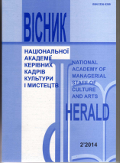СOMPOSER’S CREATIVITY FOR BANDURA LATE XX – EARLY XXI CENTURY: STYLISTIC ASPECTS
DOI:
https://doi.org/10.32461/2226-3209.2.2014.137985Keywords:
bandura, Ukrainian сomposer’s creative work for bandura, style, neo-style, academic music, mass musicAbstract
Musical compositions of Ukrainian composers, both professionals and amateurs for bandura, belonging to different genres and styles and written at the turn of the XX–XXI centuries have been analyzed in the current article.
Among those composers who have been working fruitfully for the last three decades in the field of music for bandura are such names as O. Herasimenko, V. Martinyuck, V. Vlasov, V. Zubits’kiy, Y. Milka and others; performers-bandurists – R. Hrin’kiv, H. Matviyiv, H. Toporovs’ka, T. Lazurkevitch and others. Their creative work fits in naturally with the style trends of the contemporary academic (neo-folklorism, neo-romanticism, neo-baroque, neo-classicism, neo-impressionism) and mass (ethno jazz, new age, world music, etc) music.
It is indicated in the current article that the important place in the creative work for bandura is still occupied by the folklore theme. Nevertheless musical pieces which became indicative for nowadays have become the ones that combine the folklore background with the characteristic features of the contemporary musical thinking. Therefore they fit in with the non-folklore trend (Chamber symphony "Series of hutsul meditative sketches" for the chamber orchestra, bayan and bandura by V. Pavlickovs’kiy, Allusions on Ukrainian folk theme "How chumack has gone" by V. Martinyuck, etc.).
In the creative work of the modern Ukrainian composers for bandura a neo-romantic trend was implemented in a persuasive way ("Concertino in a romanic style" for the voice and bandura by V. Vlasov, "On the wings of dreams" by O. Herasymenko, "A farewell melody" by V. Martinyuck, etc.).
The natural sonority of the sounding, richness of overtone scale and therefore a specific sound "train", not equal power of sound for different registers – these and other characteristic features of acoustic nature of bandura attract composers who are prone for implementation of neo-impressionist musical images (a vocal cycle "The Lake of white lotuses" for alt, flute, percussions, bandura and voice by O. Rudyans’kiy (verses by ancient Chinese poet Bo Ts’u E)), "After the rain" for voice and bandura by Y. Milka (words by K. Zhukovs’kiy), "Water-colours" by L. Kohans’ka-Fedorova for bandura solo, etc.)
A certain timbre similarity of bandura to the instruments of chordophone-string group which causes certain associations with the instruments of baroque epoch furthers workers of art to apply to the art-image musical palette of an appropriate epoch. In this sense neo-baroque musical pieces are exemplary ("Cuckoo of the time" for the ensemble of bandura performers, flute, cello, vibraphone and percussions by V. Martinuck, "Harpsichord" for bandura solo by V. Vlasov).
Neo-classicism in bandura music is represented with polyphonic musical pieces, concerts, suites also markedwith the contemporary composer’s language ("Invention", "Fugue on the folk theme", "Prelude and fugue on the themes of Ukrainian songs" by V. Martinyuck, etc.)
In a number of musical pieces of the contemporary composers some features of postmodernism have been detected ("Sonata dedicated to the memory of K. Myaskov" by V. Zubits’kiy, "Con moto" by V. Martinyuck, "Burleska" by V. Pavlikovs’kiy, etc.).
A number of musical pieces for bandura in jazz style belong to both professional composers and amateurs (improvisational music for the quartet of saxophones, solo percussionist, bandura performer and the author (pianist) "A prima vista" ("From the first sight") by I. Taranenko, "Girls fromOdessa" for bayan and bandura by V. Vlasov). A characteristic feature for the composer’s creative work of bandura performers is the synthesis of different style trends of mass music which we can see in the musical pieces by K. Rusnak, H. Matiyeva, T. Starenkova and others.
Composer’s creative work for bandura at the turn of XX – XXI cent. witnesses richness of its thematical, imagestyle panorama, a specific interest of the art workers to neo-styles – such as neo-folklore, neo-romanticism, neobaroque, neo-classicism, neo-impressionism, trends of mass musical culture (like ethno-jazz, new age, world music, etc.)
and is often marked with features of postmodernism, like experimenting in the sphere of synthesis of different style trends. The search for combining timbre of bandura and other instruments (including acoustic and electro-instruments), inventing of new specific ways of playing bandura, use of sophisticated intonation complexes, modern techniques in composer’s work are characteristic on the language-technological level.
Downloads
Published
Issue
Section
License
Authors who publish with this journal agree to the following terms:
1. Authors retain copyright and grant the journal right of first publication with the work simultaneously licensed under a Creative Commons Attribution License that allows others to share the work with an acknowledgement of the work's authorship and initial publication in this journal.
2. Authors are able to enter into separate, additional contractual arrangements for the non-exclusive distribution of the journal's published version of the work (e.g., post it to an institutional repository or publish it in a book), with an acknowledgement of its initial publication in this journal.
3. Authors are permitted and encouraged to post their work online (e.g., in institutional repositories or on their website) prior to and during the submission process, as it can lead to productive exchanges, as well as earlier and greater citation of published work (See The Effect of Open Access).


